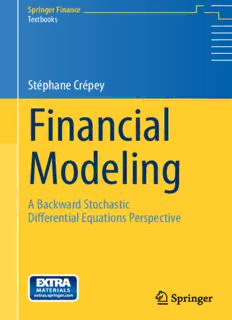
Financial Modeling: A Backward Stochastic Differential Equations Perspective PDF
Preview Financial Modeling: A Backward Stochastic Differential Equations Perspective
Springer Finance Textbooks Stéphane Crépey Financial Modeling A Backward Stochastic Diff erential Equations Perspective Springer Finance Textbooks EditorialBoard MarcoAvellaneda GiovanniBarone-Adesi MarkBroadie MarkH.A.Davis EmanuelDerman ClaudiaKlüppelberg WalterSchachermayer Springer Finance Textbooks Springer Finance is a programme of books addressing students, academics and practitionersworkingonincreasinglytechnicalapproachestotheanalysisoffinan- cialmarkets.Itaimstocoveravarietyoftopics,notonlymathematicalfinancebut foreignexchanges,termstructure,riskmanagement,portfoliotheory,equityderiva- tives,andfinancialeconomics. ThissubseriesofSpringerFinanceconsistsofgraduatetextbooks. Forfurthervolumes: http://www.springer.com/series/11355 Stéphane Crépey Financial Modeling A Backward Stochastic Differential Equations Perspective Prof.StéphaneCrépey Départementdemathématiques, LaboratoireAnalyse&Probabilités Universitéd’EvryVald’Essone Evry,France Additionalmaterialtothisbookcanbedownloadedfromhttp://extras.springer.com Password:[978-3-642-37112-7] ISBN978-3-642-37112-7 ISBN978-3-642-37113-4(eBook) DOI10.1007/978-3-642-37113-4 SpringerHeidelbergNewYorkDordrechtLondon LibraryofCongressControlNumber:2013939614 MathematicsSubjectClassification: 91G20,91G60,91G80 JELClassification: G13,C63 ©Springer-VerlagBerlinHeidelberg2013 Thisworkissubjecttocopyright.AllrightsarereservedbythePublisher,whetherthewholeorpartof thematerialisconcerned,specificallytherightsoftranslation,reprinting,reuseofillustrations,recitation, broadcasting,reproductiononmicrofilmsorinanyotherphysicalway,andtransmissionorinformation storageandretrieval,electronicadaptation,computersoftware,orbysimilarordissimilarmethodology nowknownorhereafterdeveloped.Exemptedfromthislegalreservationarebriefexcerptsinconnection with reviews or scholarly analysis or material supplied specifically for the purpose of being entered and executed on a computer system, for exclusive use by the purchaser of the work. Duplication of this publication or parts thereof is permitted only under the provisions of the Copyright Law of the Publisher’slocation,initscurrentversion,andpermissionforusemustalwaysbeobtainedfromSpringer. PermissionsforusemaybeobtainedthroughRightsLinkattheCopyrightClearanceCenter.Violations areliabletoprosecutionundertherespectiveCopyrightLaw. Theuseofgeneraldescriptivenames,registerednames,trademarks,servicemarks,etc.inthispublication doesnotimply,evenintheabsenceofaspecificstatement,thatsuchnamesareexemptfromtherelevant protectivelawsandregulationsandthereforefreeforgeneraluse. Whiletheadviceandinformationinthisbookarebelievedtobetrueandaccurateatthedateofpub- lication,neithertheauthorsnortheeditorsnorthepublishercanacceptanylegalresponsibilityforany errorsoromissionsthatmaybemade.Thepublishermakesnowarranty,expressorimplied,withrespect tothematerialcontainedherein. Printedonacid-freepaper SpringerispartofSpringerScience+BusinessMedia(www.springer.com) To Irèneand Camille Preface Thisisabookonfinancialmodelingthatemphasizescomputationalaspects.Itgives a unified perspective on derivative pricing and hedging across asset classes and is addressedtoallthosewhoareinterestedinapplicationsofmathematicstofinance: students,quantsandacademics. The book features backward stochastic differential equations (BSDEs), which areanattractivealternativetothemorefamiliarpartialdifferentialequations(PDEs) for representing prices and Greeks of financial derivatives. First, BSDEs offer the mostunifiedsetupforpresentingthefinancialderivativespricingandhedgingtheory (asreflectedbytherelativecompactnessofthebook,givenitsratherwidescope). Second,BSDEsareatechnicallyveryflexibleandpowerfulmathematicaltoolfor elaborating the theory with all the required mathematical rigor and proofs. Third, BSDEs are also useful for the numerical solution of high-dimensional nonlinear pricingproblemssuchasthenonlinearCVAandfundingissueswhichhavebecome importantsincethegreatcrisis[30,80,81]. Structure oftheBook Part I provides a course in stochastic processes, beginning at a quite elementary levelinordertogentlyintroducethereadertothemathematicaltoolsthatareneeded subsequently.PartIIdealswiththederivationofthepricingequationsoffinancial claimsandtheirexplicitsolutionsinafewcaseswheretheseareeasilyobtained,al- thoughtypicallytheseequationshavetobesolvednumericallyasisdoneinPartIII. PartIVprovidestwocomprehensiveapplicationsofthebook’sapproachthatillus- trate the versatility of simulation/regression pricing schemes for high-dimensional pricingproblems.PartVprovidesathoroughmathematicaltreatmentoftheBSDEs andPDEsthatareoffundamentalimportanceforourapproach.Finally,PartVIis anextendedappendixwithtechnicalproofs,exercisesandcorrectedproblemsets. vii viii Preface Outline Chapters1–3provideasurveyofusefulmaterialfromstochasticanalysis.InChap.4 werecallthebasicsoffinancialtheorywhicharenecessaryforunderstandinghow therisk-neutralpricingequationofagenericcontingentclaimisderived.Thischap- tergivesa unifiedviewon thetheoryofpricingandhedgingfinancialderivatives, using BSDEs as a main tool. We then review, in Chap. 5, benchmark models on referencederivativemarkets.Chapter6isaboutMonteCarlopricingmethodsand Chaps.7and8dealwithdeterministicpricingschemes:treesinChap.7andfinite differencesinChap.8. Notethatthereisnohermeticfrontierbetweendeterministicandstochasticpric- ingschemes.Inessence,allthesenumericalschemesarebasedontheideaofprop- agating the solution, starting from a surface of the time-space domain on which it isknown(typically:thematurityofaclaim),alongsuitable(random)“characteris- tics”oftheproblem.Here“characteristics”referstoRiemann’smethodforsolving hyperbolic first-order equations (see Chap. 4 of [191]). From the point of view of controltheory,allthesenumericalschemescanbeviewedasvariantsofBellman’s dynamicprogrammingprinciple[26].MonteCarlopricingschemesmaythusbere- gardedasone-time-stepmultinomialtrees,convergingtoalimitingjumpdiffusion whenthenumberofspacediscretizationpoints(treebranches)goestoinfinity.The difference between a tree method in the usual sense and a Monte Carlo method is thataMonteCarlocomputationmeshisstochasticallygeneratedandnonrecombin- ing. Pricesofliquidfinancialinstrumentsaregivenbythemarketandaredetermined bysupply-and-demand.Liquidmarketpricesarethusactuallyusedbymodelsinthe “reverse-engineering” mode that consists in calibrating a model to market prices. This calibration process is the topic of Chap. 9. Once calibrated to the market, a model can be used for Greeking and/or for pricing more exotic claims (Greeking meanscomputingrisksensitivitiesinordertoset-uparelatedhedge). Analogiesanddifferencesbetweensimulationanddeterministicpricingschemes aremostclearlyvisibleinthecontextofpricingbysimulationclaimswithearlyex- ercise features (American and/or cancelable claims). Early exercisable claims can be priced by hybrid “nonlinear Monte Carlo” pricing schemes in which dynamic programmingequations,similartothoseusedindeterministicschemes,areimple- mentedonstochasticallygeneratedmeshes.Suchhybridschemesarethetopicsof Chaps.10and11,indiffusionandinpurejumpsetups,respectively.Again,thisis presentlybecomingquitetopicalforthepurposeofCVAcomputations. Chapters 12–14 develop, within a rigorous mathematical framework, the con- nection between backward stochastic differential equations and partial differential equations. This is done in a jump-diffusion setting with regime switching, which coversallthemodelsconsideredinthebook. FinallyChap.15gathersthemostdemandingproofsofPartV,Chap.16isde- votedtoexercisesforPartIandChap.17providessolvedproblemsetsforPartsII andIII. Preface ix Fig.1 Gettingstartedwiththebook:roadmapof“afirstandpartialreading”fordifferentaudi- ences.Green:Students.Blue:Quants.Red:Academics Roadmap Giventhedualnatureoftheproposedaudience(scholarsandquants),wehavepro- videdmorebackgroundmaterialonstochasticprocesses,pricingequationsandnu- mericalmethodsthanisneededforourmainpurposes.Yetwehavenotavoidedthe sometimesdifficultmathematicaltechniquethatisneededfordeepunderstanding. So, for the convenience of readers, we signal sections that contain advanced ma- terial with an asterisk (*) or even a double asterisk (**) for the still more difficult portions. Our ambition is, of course, that any reader should ultimately benefit from all partsofthebook.Weexpectthatanaveragereaderwillneedtwoorthreeattempts atreadingatdifferentlevelsforachievingthisobjective.Toprovideadditionalguid- ance,weproposethefollowingroadmapofwhata“firstandpartial”readingofthe bookcouldbeforthree“stylized”readers(seeFig.1forapictorialrepresentation): a student (in “green” on the figure), a quant (“blue” audience) and an academic (“red”;the“blueandred”boxinthechartmayrepresentavaluablefirstreadingfor bothquantsandacademics): • for a graduate student (“green”), we recommend a first reading of the book at a classical quantitative and numerical finance textbook level, as follows in this order: – startbyChaps.1–3(exceptforthestarredsectionsofChap.3),alongwiththe accompanying(generallyclassical)exercisesofChap.16,1 1Solutionsoftheexercisesareavailableforcourseinstructors. x Preface – thenjumptoChaps.5to9,dothecorrectedproblemsofChap.17andrunthe accompanyingMatlabscripts(http://extras.springer.com); • foraquant(“blue”): – startwiththestarredsectionsofChap.3,followedbyChap.4, – thenjumptoChaps.10and11; • foranacademicsoraPhDstudent(“red”): – startwiththestarredsectionsofChap.3,followedbyChap.4, – thenjumptoChaps.12to14,alongwiththerelatedproofsinChap.15. TheRoleofBSDEs Althoughthisbookisn’texclusivelydedicatedtoBSDEs,itfeaturestheminvarious contextsasacommonthreadforguidingreadersthroughtheoreticalandcomputa- tional aspects of financial modeling. For readers who are especially interested in BSDEs,werecommend: • Section3.5foramathematicalintroductionofBSDEsataheuristiclevel, • Chapter4fortheirgeneralconnectionwithhedging, • Section6.10andChap.10fornumericalaspectsand • PartVandChap.15fortherelatedmathematics. InSect.11.5wealsogiveaprimerofCVAcomputationsusingsimulation/regression techniquesthataremotivatedbyBSDEnumericalschemes,eventhoughnoBSDEs appear explicitly. More on this will be found in [30], for which the present book shouldbeausefulcompanion. BibliographicGuidelines Toconcludethispreface,hereareafewgeneralreferences: • on random processes and stochastic analysis, often with connections to finance (Chaps.1–3):[149,159,167,174,180,205,228]; • onmartingalemodelinginfinance(Chap.4):[93,114,159,191,208,245]; • onmarketmodels(Chap.5):[43,44,58,131,146,208,230,241]; • onMonteCarlomethods(Chap.6):[133,176,226]; • ondeterministicpricingschemes(Chaps.7and8):[1,12,27,104,172,174,207, 248,254,256]; • onmodelcalibration(Chap.9):[71,116,213]; • onsimulation/regressionpricingschemes(Chaps.10and11):[133,136]; • onBSDEsandPDEs,especiallyinconnectionwithfinance(Chaps.12–14):[96, 113,114,122,164,197,224].
Description: